
Holy Week is the most sacred week in the liturgical year in Christianity. For all Christian traditions, it is a moveable observance. In Eastern Christianity, which also calls it Great Week, it is the week following Great Lent and Lazarus Saturday, starting on the evening of Palm Sunday and concluding on the evening of Great Saturday. In Western Christianity, Holy Week is the sixth and last week of Lent, beginning with Palm Sunday and concluding on Holy Saturday.

St Mary's Church, known also as St Mary's Pro-Cathedral or simply the Pro-Cathedral, the Chapel in Marlborough Street or the Pro, is a pro-cathedral and is the episcopal seat of the Roman Catholic Archbishop of Dublin and Primate of Ireland.
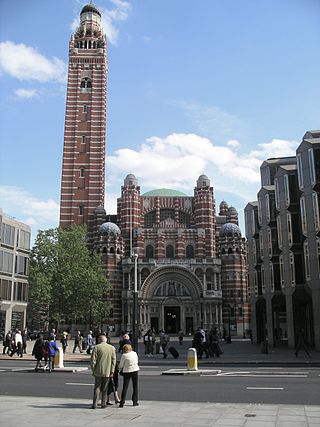
The Metropolitan Cathedral of the Most Precious Blood, known as Westminster Cathedral, is the largest Roman Catholic church in England and Wales and the seat of the Cardinal Archbishop of Westminster.
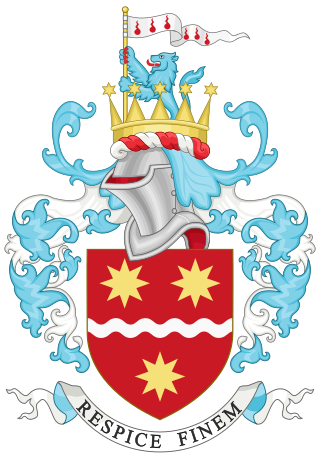
The London Oratory School, also known as "The Oratory" or "The London Oratory" to distinguish it from other schools, is a Catholic comprehensive secondary school for boys aged 7–18 and girls aged 16–18 in West Brompton. Founded in 1863 by The Fathers of The London Oratory then in Chelsea, London, it is historically linked to two fellow Oratorian institutions: the nearby Brompton Oratory and The Oratory School in Oxfordshire. The school is known for the quality of its choral and instrumental music and is one of England's oldest Catholic schools. The London Oratory School was named in The Sunday Times as one of the 'Top 10 Comprehensive Schools in the UK' for both 2022 and 2023.

The Confederation of Oratories of Saint Philip Neri, abbreviated C.O. and commonly known as the Oratorians, is a Catholic society of apostolic life of pontifical right for men who live together in a community bound together by no formal vows but only with the bond of charity.

The Use of Sarum is the liturgical use of the Latin rites developed at Salisbury Cathedral and used from the late eleventh century until the English Reformation. It is largely identical to the Roman Rite, with about ten per cent of its material drawn from other sources. The cathedral's liturgy was widely respected during the late Middle Ages, and churches throughout the British Isles and parts of northwestern Europe adapted its customs for celebrations of the Eucharist and canonical hours. The use has a unique ecumenical position in influencing and being authorized by Catholic, Eastern Orthodox, and Anglican churches.

The Diocese of Westminster is a Latin archdiocese of the Catholic Church in England. The diocese consists of most of London north of the River Thames and west of the River Lea, the borough of Spelthorne, and the county of Hertfordshire, which lies immediately to London's north.
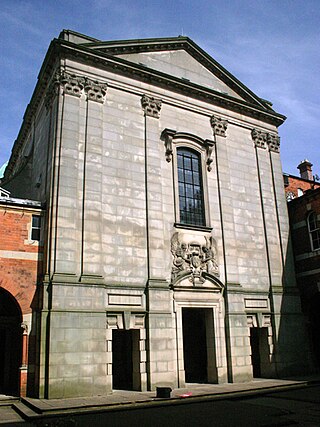
The Birmingham Oratory is a Catholic religious community of the Oratory of St. Philip Neri, located in the Edgbaston area of Birmingham. The community was founded in 1849 by John Henry Newman as the first house of that congregation in England.

The London Oratory, officially the Congregation of the Oratory of St Philip Neri in London, is a Catholic community of priests living under the rule of life established by Philip Neri (1515-1595). It is located in an Oratory House, next to the Church of the Immaculate Heart of Mary in the Brompton Road, Royal Borough of Kensington and Chelsea, London, SW7.

The Oxford Oratory Church of St Aloysius Gonzaga is the Catholic parish church for the centre of Oxford, England. It is located at 25 Woodstock Road, next to Somerville College. The church is served by the Congregation of the Oratory.
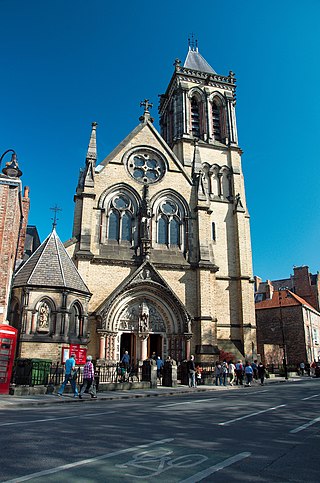
The Oratory Church of Saint Wilfrid, York is a Catholic church in York, England.

The Cathedral of St Stephen is the heritage-listed cathedral church of the Roman Catholic Archdiocese of Brisbane and seat of its archbishop in Brisbane, Queensland, Australia. St Stephen's was only meant to serve as a temporary seat for the archbishop, and plans for a replacement were made with the Holy Name Cathedral, however the cathedral was never built.
(Greek: εὐκτηρίου) In the canon law of the Catholic Church, an oratory is a place which is set aside by permission of an ordinary for divine worship, for the convenience of some community or group of the faithful who assemble there, but to which other members of the faithful may have access with the consent of the competent superior. The word oratory comes from the Latin verb orare, to pray.

CIEL UK is the British branch of CIEL, an international Roman Catholic society that is dedicated to scholarly analysis and pastoral familiarity of the traditional liturgy of the Roman Catholic Church within the English-speaking world, in collaboration with CIEL.
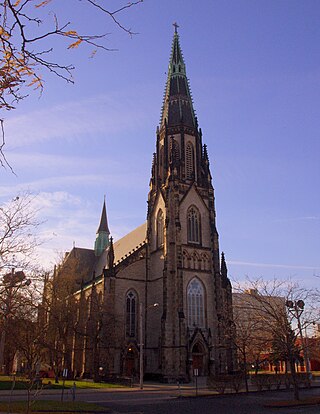
St. Joseph Shrine, founded in 1855, is a historic German Catholic church located at 1828 Jay Street in the Eastern Market–Lafayette Park neighborhood area just outside downtown Detroit, Michigan, on the city's central east side. The building was listed on the National Register of Historic Places in 1972, and deemed "of national importance" because of its stained glass. Three subsidiary buildings—the rectory, convent, and the Wermers House—were added to the listing in 1992. It is under the jurisdiction of the Archdiocese of Detroit, and presently a shrine dedicated to the celebration of the pre-Vatican II liturgy under the care of the canons of the Institute of Christ the King Sovereign Priest.

St. Francis de Sales Church is a Roman Catholic Oratory located in south St. Louis, Missouri, United States. It is the second largest church in the Archdiocese of St. Louis after the cathedral-basilica. The church is popularly known as the "Cathedral of South St. Louis".

The Church of Our Lady of the Assumption and the English Martyrs, also known as the Church of Our Lady and the English Martyrs (OLEM), is an English Roman Catholic parish church located at the junction of Hills Road and Lensfield Road in southeast Cambridge. It is a large Gothic Revival church built between 1885 and 1890, and is a Grade I listed building.

St James' Church is a large English Gothic Catholic church in George Street, Marylebone, London. Although currently situated in George Street, the church maintains its connection with Spanish Place, the road opposite the current church, because of its historic connection with the Spanish Embassy. It is a Grade II* listed building.
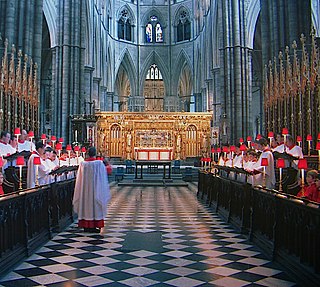
Evensong is a church service traditionally held near sunset focused on singing psalms and other biblical canticles. It is loosely based on the canonical hours of vespers and compline. Old English speakers translated the Latin word vesperas as æfensang, which became 'evensong' in modern English. Typically used in reference to the Anglican daily office's evening liturgy, it can also refer to the pre-Reformation form of vespers or services of evening prayer from other denominations, particularly within the Anglican Use of the Catholic Church.

St Alban-on-the-Moors Church, Splott, also known simply as The Cardiff Oratory or St Alban's Church, is a Roman Catholic church in Splott, Cardiff, Wales. Since 2019, the church is administered by the Fathers and Brothers of the Cardiff Oratory.


























